Report: Effective Communication in Health and Social Care Practices
VerifiedAdded on 2021/02/21
|9
|1996
|110
Report
AI Summary
This report comprehensively examines the crucial role of effective communication and interpersonal interaction within the health and social care (HSC) sector. It begins by highlighting the importance of communication for patient care and the development of supportive bonds among healthcare professionals. The report then delves into communication theories relevant to HSC, such as Argyle's Communication Cycle, and identifies key factors influencing communication, including culture, listening skills, and emotional intelligence. Furthermore, it outlines strategies to overcome communication barriers, emphasizing the need for worker training, a positive work culture, and effective listening. The report includes case studies of one-to-one and group interactions in HSC settings, specifically addressing dementia care, and concludes by underscoring the significance of effective communication for improving patient outcomes and overall well-being. The report is supported by multiple references to journals and books.
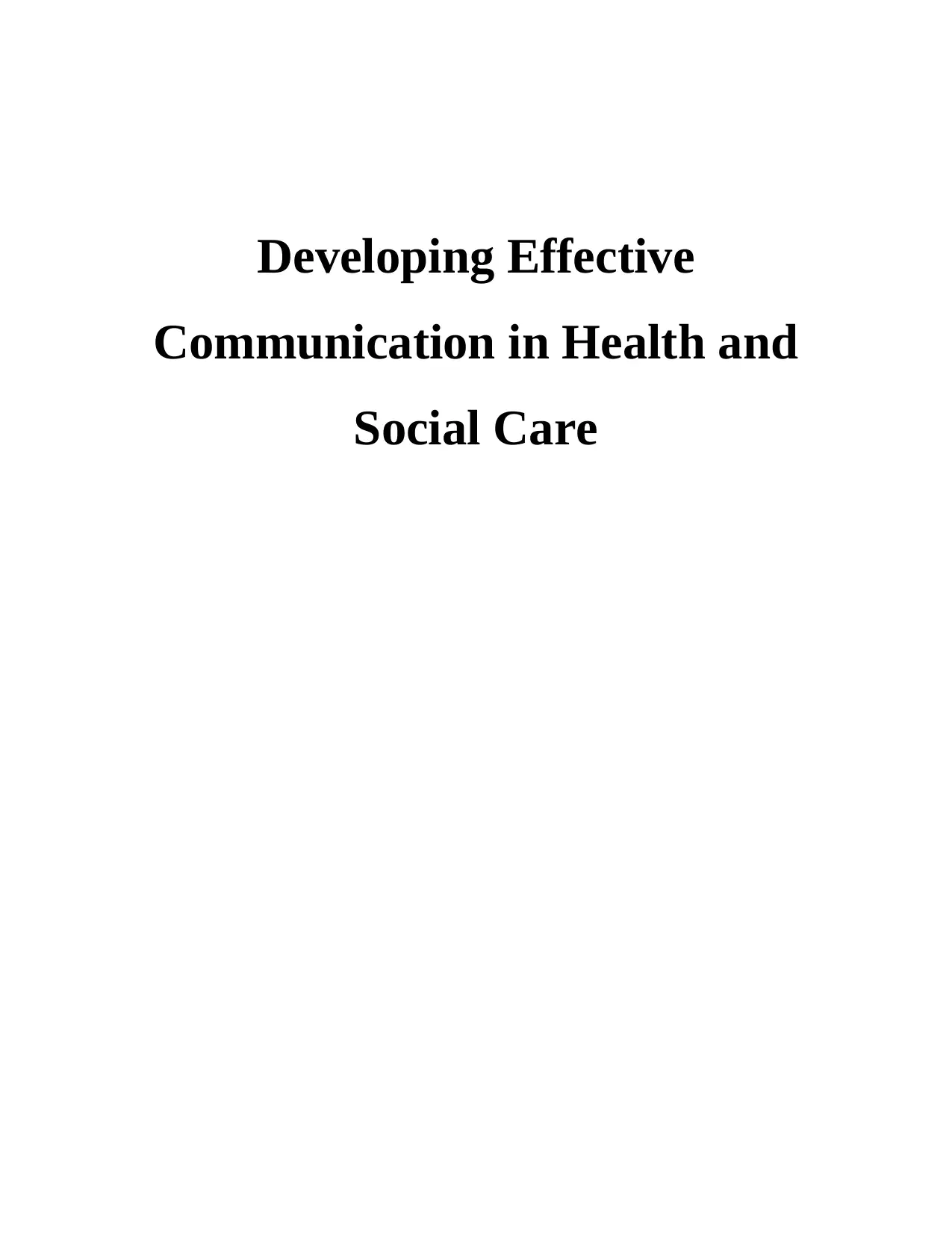
Developing Effective
Communication in Health and
Social Care
Communication in Health and
Social Care
Paraphrase This Document
Need a fresh take? Get an instant paraphrase of this document with our AI Paraphraser
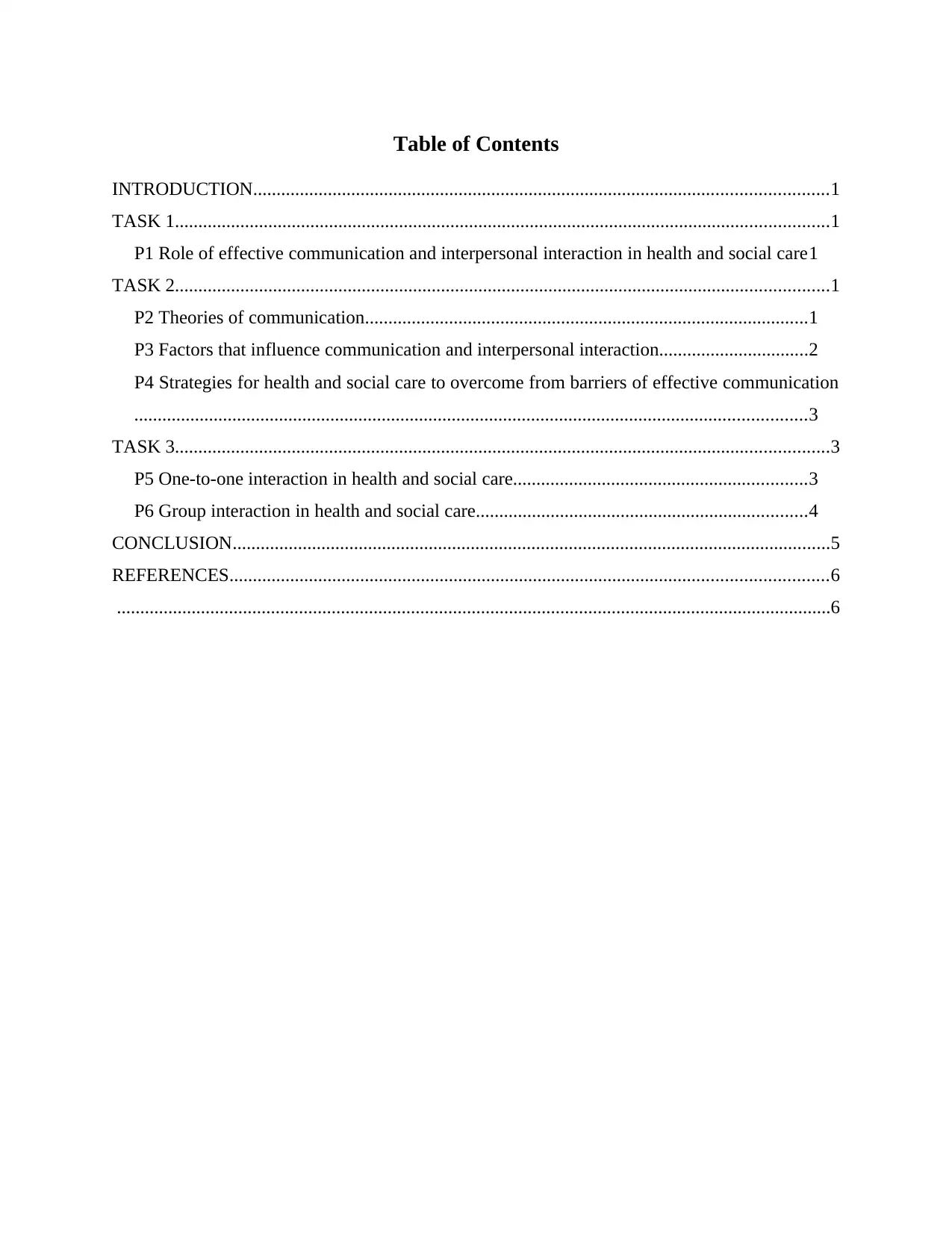
Table of Contents
INTRODUCTION...........................................................................................................................1
TASK 1............................................................................................................................................1
P1 Role of effective communication and interpersonal interaction in health and social care1
TASK 2............................................................................................................................................1
P2 Theories of communication...............................................................................................1
P3 Factors that influence communication and interpersonal interaction................................2
P4 Strategies for health and social care to overcome from barriers of effective communication
................................................................................................................................................3
TASK 3............................................................................................................................................3
P5 One-to-one interaction in health and social care...............................................................3
P6 Group interaction in health and social care.......................................................................4
CONCLUSION................................................................................................................................5
REFERENCES................................................................................................................................6
.........................................................................................................................................................6
INTRODUCTION...........................................................................................................................1
TASK 1............................................................................................................................................1
P1 Role of effective communication and interpersonal interaction in health and social care1
TASK 2............................................................................................................................................1
P2 Theories of communication...............................................................................................1
P3 Factors that influence communication and interpersonal interaction................................2
P4 Strategies for health and social care to overcome from barriers of effective communication
................................................................................................................................................3
TASK 3............................................................................................................................................3
P5 One-to-one interaction in health and social care...............................................................3
P6 Group interaction in health and social care.......................................................................4
CONCLUSION................................................................................................................................5
REFERENCES................................................................................................................................6
.........................................................................................................................................................6

⊘ This is a preview!⊘
Do you want full access?
Subscribe today to unlock all pages.

Trusted by 1+ million students worldwide
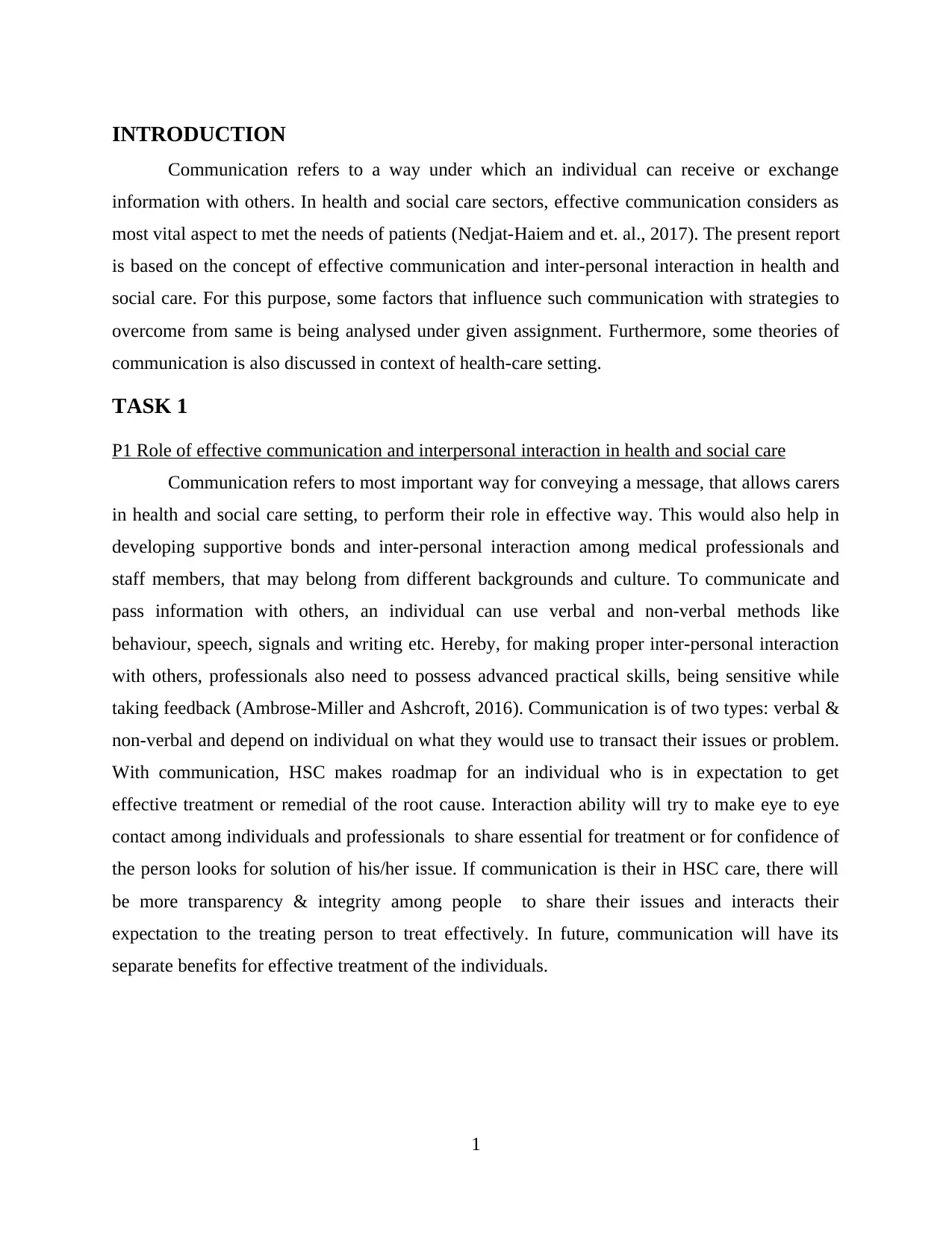
INTRODUCTION
Communication refers to a way under which an individual can receive or exchange
information with others. In health and social care sectors, effective communication considers as
most vital aspect to met the needs of patients (Nedjat-Haiem and et. al., 2017). The present report
is based on the concept of effective communication and inter-personal interaction in health and
social care. For this purpose, some factors that influence such communication with strategies to
overcome from same is being analysed under given assignment. Furthermore, some theories of
communication is also discussed in context of health-care setting.
TASK 1
P1 Role of effective communication and interpersonal interaction in health and social care
Communication refers to most important way for conveying a message, that allows carers
in health and social care setting, to perform their role in effective way. This would also help in
developing supportive bonds and inter-personal interaction among medical professionals and
staff members, that may belong from different backgrounds and culture. To communicate and
pass information with others, an individual can use verbal and non-verbal methods like
behaviour, speech, signals and writing etc. Hereby, for making proper inter-personal interaction
with others, professionals also need to possess advanced practical skills, being sensitive while
taking feedback (Ambrose-Miller and Ashcroft, 2016). Communication is of two types: verbal &
non-verbal and depend on individual on what they would use to transact their issues or problem.
With communication, HSC makes roadmap for an individual who is in expectation to get
effective treatment or remedial of the root cause. Interaction ability will try to make eye to eye
contact among individuals and professionals to share essential for treatment or for confidence of
the person looks for solution of his/her issue. If communication is their in HSC care, there will
be more transparency & integrity among people to share their issues and interacts their
expectation to the treating person to treat effectively. In future, communication will have its
separate benefits for effective treatment of the individuals.
1
Communication refers to a way under which an individual can receive or exchange
information with others. In health and social care sectors, effective communication considers as
most vital aspect to met the needs of patients (Nedjat-Haiem and et. al., 2017). The present report
is based on the concept of effective communication and inter-personal interaction in health and
social care. For this purpose, some factors that influence such communication with strategies to
overcome from same is being analysed under given assignment. Furthermore, some theories of
communication is also discussed in context of health-care setting.
TASK 1
P1 Role of effective communication and interpersonal interaction in health and social care
Communication refers to most important way for conveying a message, that allows carers
in health and social care setting, to perform their role in effective way. This would also help in
developing supportive bonds and inter-personal interaction among medical professionals and
staff members, that may belong from different backgrounds and culture. To communicate and
pass information with others, an individual can use verbal and non-verbal methods like
behaviour, speech, signals and writing etc. Hereby, for making proper inter-personal interaction
with others, professionals also need to possess advanced practical skills, being sensitive while
taking feedback (Ambrose-Miller and Ashcroft, 2016). Communication is of two types: verbal &
non-verbal and depend on individual on what they would use to transact their issues or problem.
With communication, HSC makes roadmap for an individual who is in expectation to get
effective treatment or remedial of the root cause. Interaction ability will try to make eye to eye
contact among individuals and professionals to share essential for treatment or for confidence of
the person looks for solution of his/her issue. If communication is their in HSC care, there will
be more transparency & integrity among people to share their issues and interacts their
expectation to the treating person to treat effectively. In future, communication will have its
separate benefits for effective treatment of the individuals.
1
Paraphrase This Document
Need a fresh take? Get an instant paraphrase of this document with our AI Paraphraser
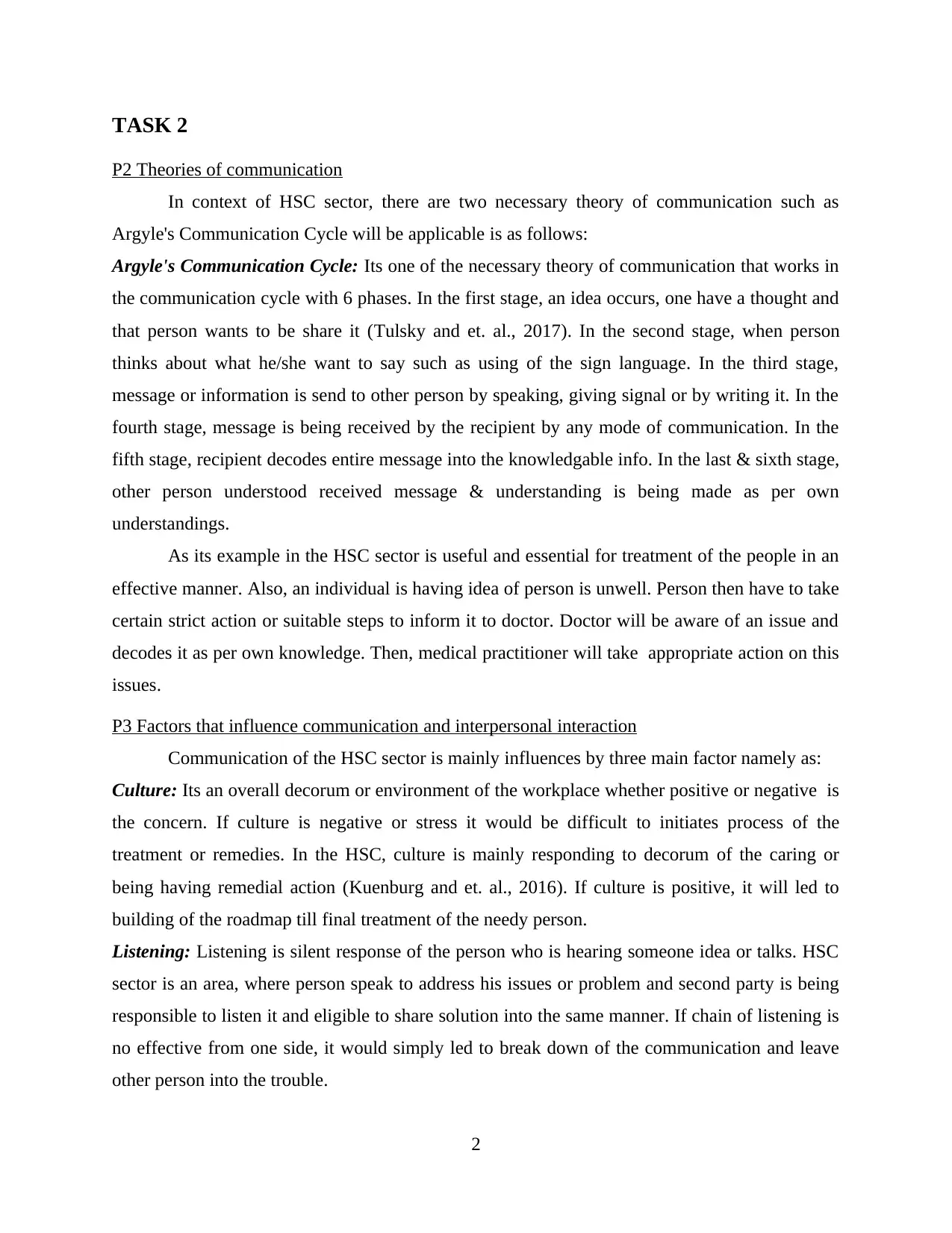
TASK 2
P2 Theories of communication
In context of HSC sector, there are two necessary theory of communication such as
Argyle's Communication Cycle will be applicable is as follows:
Argyle's Communication Cycle: Its one of the necessary theory of communication that works in
the communication cycle with 6 phases. In the first stage, an idea occurs, one have a thought and
that person wants to be share it (Tulsky and et. al., 2017). In the second stage, when person
thinks about what he/she want to say such as using of the sign language. In the third stage,
message or information is send to other person by speaking, giving signal or by writing it. In the
fourth stage, message is being received by the recipient by any mode of communication. In the
fifth stage, recipient decodes entire message into the knowledgable info. In the last & sixth stage,
other person understood received message & understanding is being made as per own
understandings.
As its example in the HSC sector is useful and essential for treatment of the people in an
effective manner. Also, an individual is having idea of person is unwell. Person then have to take
certain strict action or suitable steps to inform it to doctor. Doctor will be aware of an issue and
decodes it as per own knowledge. Then, medical practitioner will take appropriate action on this
issues.
P3 Factors that influence communication and interpersonal interaction
Communication of the HSC sector is mainly influences by three main factor namely as:
Culture: Its an overall decorum or environment of the workplace whether positive or negative is
the concern. If culture is negative or stress it would be difficult to initiates process of the
treatment or remedies. In the HSC, culture is mainly responding to decorum of the caring or
being having remedial action (Kuenburg and et. al., 2016). If culture is positive, it will led to
building of the roadmap till final treatment of the needy person.
Listening: Listening is silent response of the person who is hearing someone idea or talks. HSC
sector is an area, where person speak to address his issues or problem and second party is being
responsible to listen it and eligible to share solution into the same manner. If chain of listening is
no effective from one side, it would simply led to break down of the communication and leave
other person into the trouble.
2
P2 Theories of communication
In context of HSC sector, there are two necessary theory of communication such as
Argyle's Communication Cycle will be applicable is as follows:
Argyle's Communication Cycle: Its one of the necessary theory of communication that works in
the communication cycle with 6 phases. In the first stage, an idea occurs, one have a thought and
that person wants to be share it (Tulsky and et. al., 2017). In the second stage, when person
thinks about what he/she want to say such as using of the sign language. In the third stage,
message or information is send to other person by speaking, giving signal or by writing it. In the
fourth stage, message is being received by the recipient by any mode of communication. In the
fifth stage, recipient decodes entire message into the knowledgable info. In the last & sixth stage,
other person understood received message & understanding is being made as per own
understandings.
As its example in the HSC sector is useful and essential for treatment of the people in an
effective manner. Also, an individual is having idea of person is unwell. Person then have to take
certain strict action or suitable steps to inform it to doctor. Doctor will be aware of an issue and
decodes it as per own knowledge. Then, medical practitioner will take appropriate action on this
issues.
P3 Factors that influence communication and interpersonal interaction
Communication of the HSC sector is mainly influences by three main factor namely as:
Culture: Its an overall decorum or environment of the workplace whether positive or negative is
the concern. If culture is negative or stress it would be difficult to initiates process of the
treatment or remedies. In the HSC, culture is mainly responding to decorum of the caring or
being having remedial action (Kuenburg and et. al., 2016). If culture is positive, it will led to
building of the roadmap till final treatment of the needy person.
Listening: Listening is silent response of the person who is hearing someone idea or talks. HSC
sector is an area, where person speak to address his issues or problem and second party is being
responsible to listen it and eligible to share solution into the same manner. If chain of listening is
no effective from one side, it would simply led to break down of the communication and leave
other person into the trouble.
2
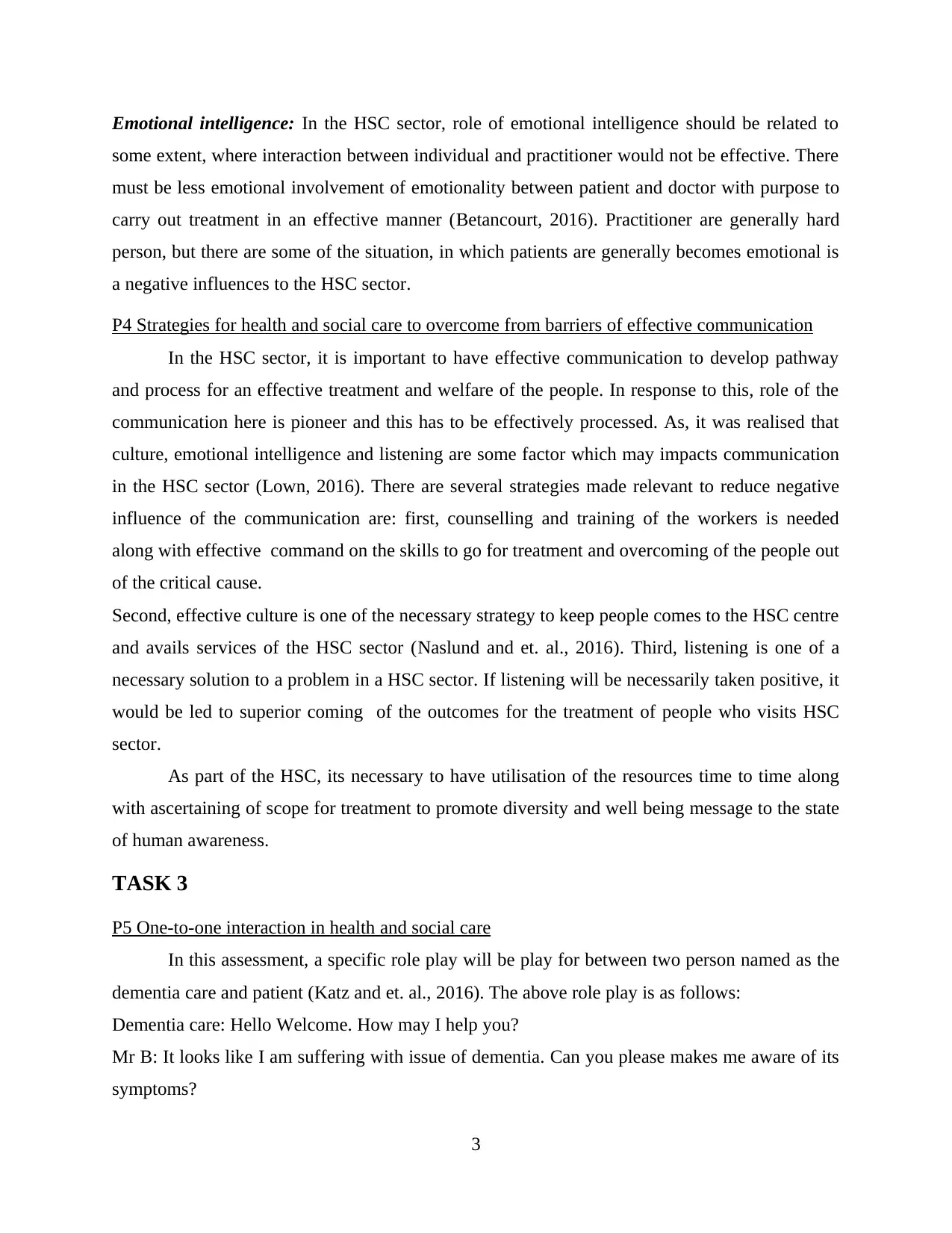
Emotional intelligence: In the HSC sector, role of emotional intelligence should be related to
some extent, where interaction between individual and practitioner would not be effective. There
must be less emotional involvement of emotionality between patient and doctor with purpose to
carry out treatment in an effective manner (Betancourt, 2016). Practitioner are generally hard
person, but there are some of the situation, in which patients are generally becomes emotional is
a negative influences to the HSC sector.
P4 Strategies for health and social care to overcome from barriers of effective communication
In the HSC sector, it is important to have effective communication to develop pathway
and process for an effective treatment and welfare of the people. In response to this, role of the
communication here is pioneer and this has to be effectively processed. As, it was realised that
culture, emotional intelligence and listening are some factor which may impacts communication
in the HSC sector (Lown, 2016). There are several strategies made relevant to reduce negative
influence of the communication are: first, counselling and training of the workers is needed
along with effective command on the skills to go for treatment and overcoming of the people out
of the critical cause.
Second, effective culture is one of the necessary strategy to keep people comes to the HSC centre
and avails services of the HSC sector (Naslund and et. al., 2016). Third, listening is one of a
necessary solution to a problem in a HSC sector. If listening will be necessarily taken positive, it
would be led to superior coming of the outcomes for the treatment of people who visits HSC
sector.
As part of the HSC, its necessary to have utilisation of the resources time to time along
with ascertaining of scope for treatment to promote diversity and well being message to the state
of human awareness.
TASK 3
P5 One-to-one interaction in health and social care
In this assessment, a specific role play will be play for between two person named as the
dementia care and patient (Katz and et. al., 2016). The above role play is as follows:
Dementia care: Hello Welcome. How may I help you?
Mr B: It looks like I am suffering with issue of dementia. Can you please makes me aware of its
symptoms?
3
some extent, where interaction between individual and practitioner would not be effective. There
must be less emotional involvement of emotionality between patient and doctor with purpose to
carry out treatment in an effective manner (Betancourt, 2016). Practitioner are generally hard
person, but there are some of the situation, in which patients are generally becomes emotional is
a negative influences to the HSC sector.
P4 Strategies for health and social care to overcome from barriers of effective communication
In the HSC sector, it is important to have effective communication to develop pathway
and process for an effective treatment and welfare of the people. In response to this, role of the
communication here is pioneer and this has to be effectively processed. As, it was realised that
culture, emotional intelligence and listening are some factor which may impacts communication
in the HSC sector (Lown, 2016). There are several strategies made relevant to reduce negative
influence of the communication are: first, counselling and training of the workers is needed
along with effective command on the skills to go for treatment and overcoming of the people out
of the critical cause.
Second, effective culture is one of the necessary strategy to keep people comes to the HSC centre
and avails services of the HSC sector (Naslund and et. al., 2016). Third, listening is one of a
necessary solution to a problem in a HSC sector. If listening will be necessarily taken positive, it
would be led to superior coming of the outcomes for the treatment of people who visits HSC
sector.
As part of the HSC, its necessary to have utilisation of the resources time to time along
with ascertaining of scope for treatment to promote diversity and well being message to the state
of human awareness.
TASK 3
P5 One-to-one interaction in health and social care
In this assessment, a specific role play will be play for between two person named as the
dementia care and patient (Katz and et. al., 2016). The above role play is as follows:
Dementia care: Hello Welcome. How may I help you?
Mr B: It looks like I am suffering with issue of dementia. Can you please makes me aware of its
symptoms?
3
⊘ This is a preview!⊘
Do you want full access?
Subscribe today to unlock all pages.

Trusted by 1+ million students worldwide
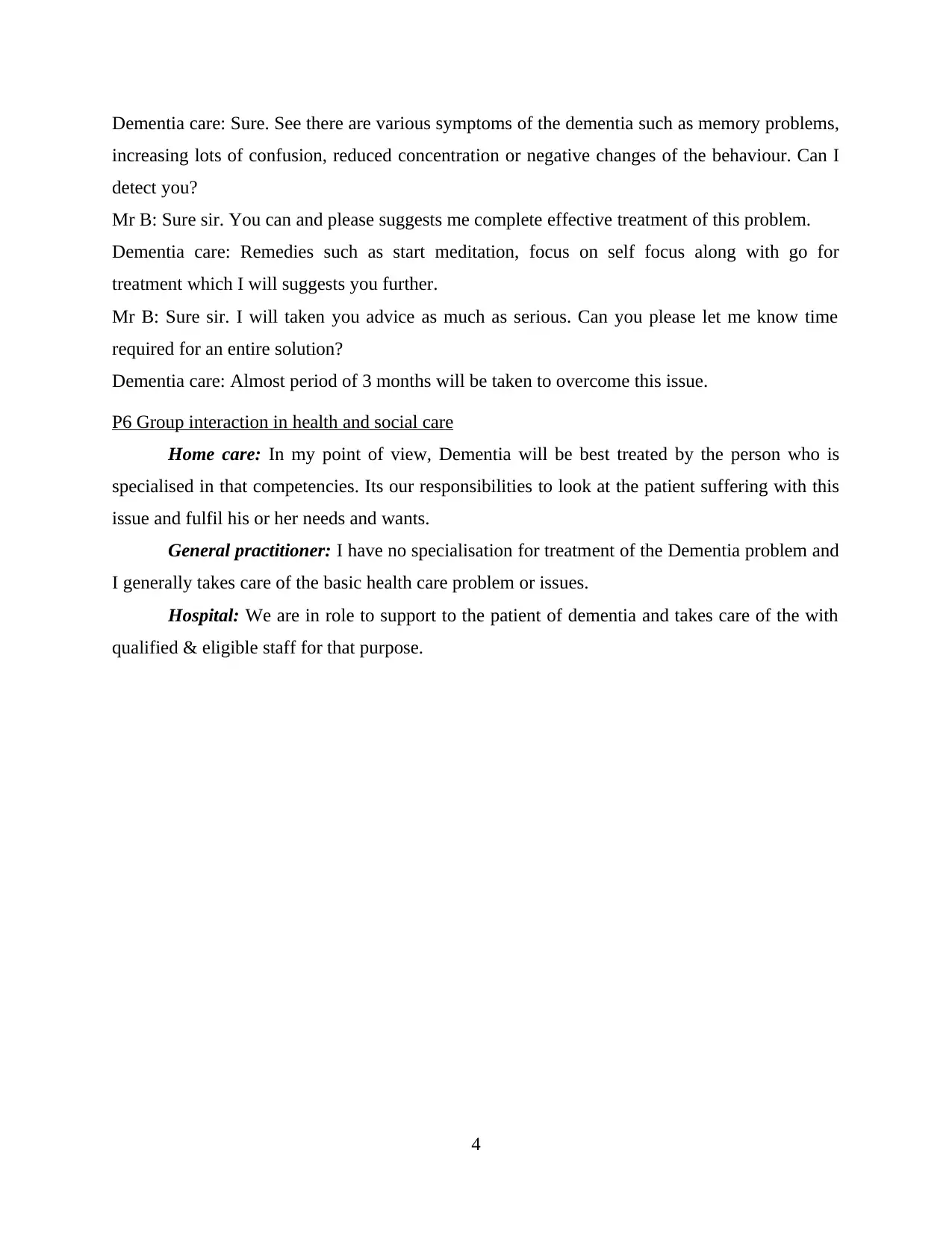
Dementia care: Sure. See there are various symptoms of the dementia such as memory problems,
increasing lots of confusion, reduced concentration or negative changes of the behaviour. Can I
detect you?
Mr B: Sure sir. You can and please suggests me complete effective treatment of this problem.
Dementia care: Remedies such as start meditation, focus on self focus along with go for
treatment which I will suggests you further.
Mr B: Sure sir. I will taken you advice as much as serious. Can you please let me know time
required for an entire solution?
Dementia care: Almost period of 3 months will be taken to overcome this issue.
P6 Group interaction in health and social care
Home care: In my point of view, Dementia will be best treated by the person who is
specialised in that competencies. Its our responsibilities to look at the patient suffering with this
issue and fulfil his or her needs and wants.
General practitioner: I have no specialisation for treatment of the Dementia problem and
I generally takes care of the basic health care problem or issues.
Hospital: We are in role to support to the patient of dementia and takes care of the with
qualified & eligible staff for that purpose.
4
increasing lots of confusion, reduced concentration or negative changes of the behaviour. Can I
detect you?
Mr B: Sure sir. You can and please suggests me complete effective treatment of this problem.
Dementia care: Remedies such as start meditation, focus on self focus along with go for
treatment which I will suggests you further.
Mr B: Sure sir. I will taken you advice as much as serious. Can you please let me know time
required for an entire solution?
Dementia care: Almost period of 3 months will be taken to overcome this issue.
P6 Group interaction in health and social care
Home care: In my point of view, Dementia will be best treated by the person who is
specialised in that competencies. Its our responsibilities to look at the patient suffering with this
issue and fulfil his or her needs and wants.
General practitioner: I have no specialisation for treatment of the Dementia problem and
I generally takes care of the basic health care problem or issues.
Hospital: We are in role to support to the patient of dementia and takes care of the with
qualified & eligible staff for that purpose.
4
Paraphrase This Document
Need a fresh take? Get an instant paraphrase of this document with our AI Paraphraser
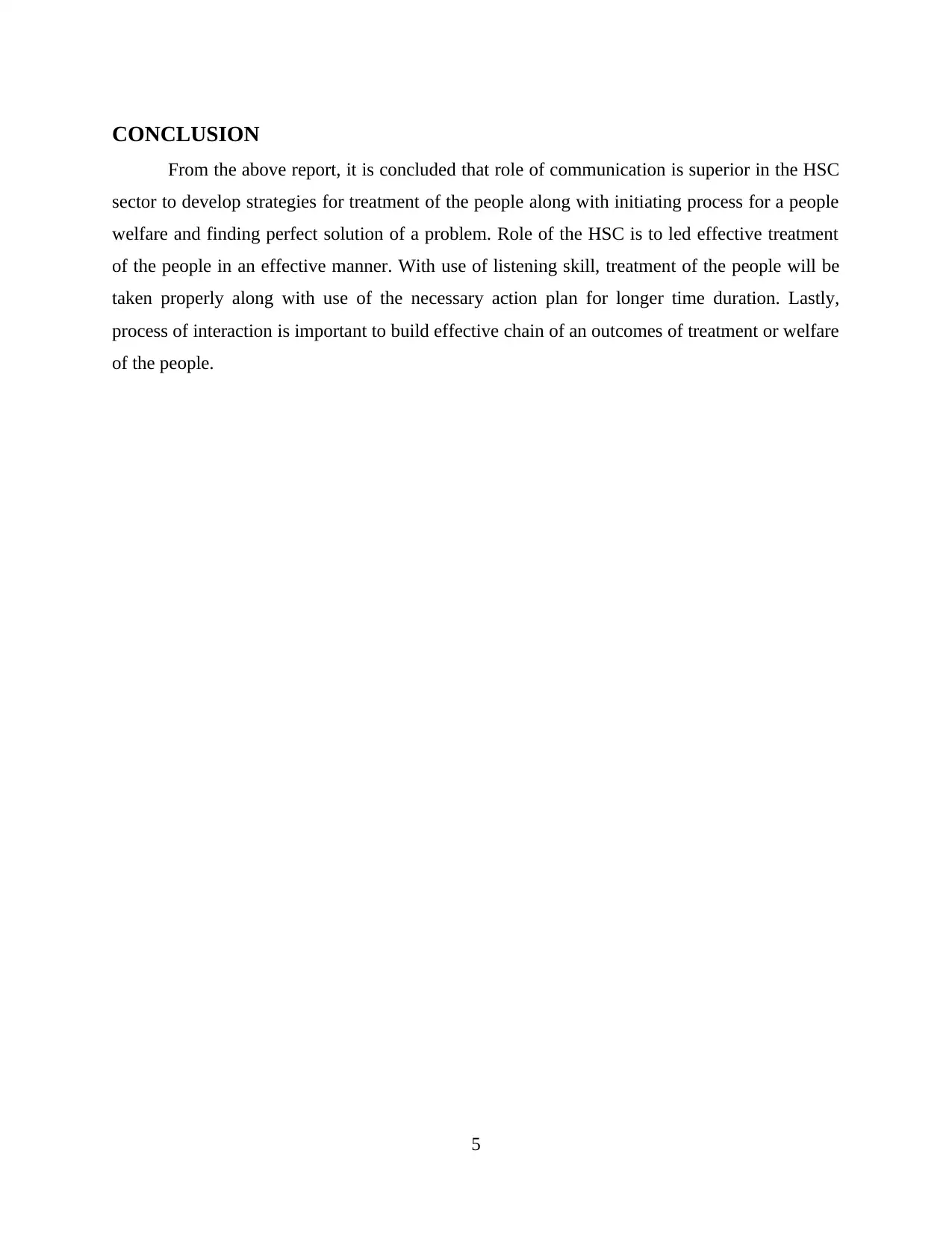
CONCLUSION
From the above report, it is concluded that role of communication is superior in the HSC
sector to develop strategies for treatment of the people along with initiating process for a people
welfare and finding perfect solution of a problem. Role of the HSC is to led effective treatment
of the people in an effective manner. With use of listening skill, treatment of the people will be
taken properly along with use of the necessary action plan for longer time duration. Lastly,
process of interaction is important to build effective chain of an outcomes of treatment or welfare
of the people.
5
From the above report, it is concluded that role of communication is superior in the HSC
sector to develop strategies for treatment of the people along with initiating process for a people
welfare and finding perfect solution of a problem. Role of the HSC is to led effective treatment
of the people in an effective manner. With use of listening skill, treatment of the people will be
taken properly along with use of the necessary action plan for longer time duration. Lastly,
process of interaction is important to build effective chain of an outcomes of treatment or welfare
of the people.
5
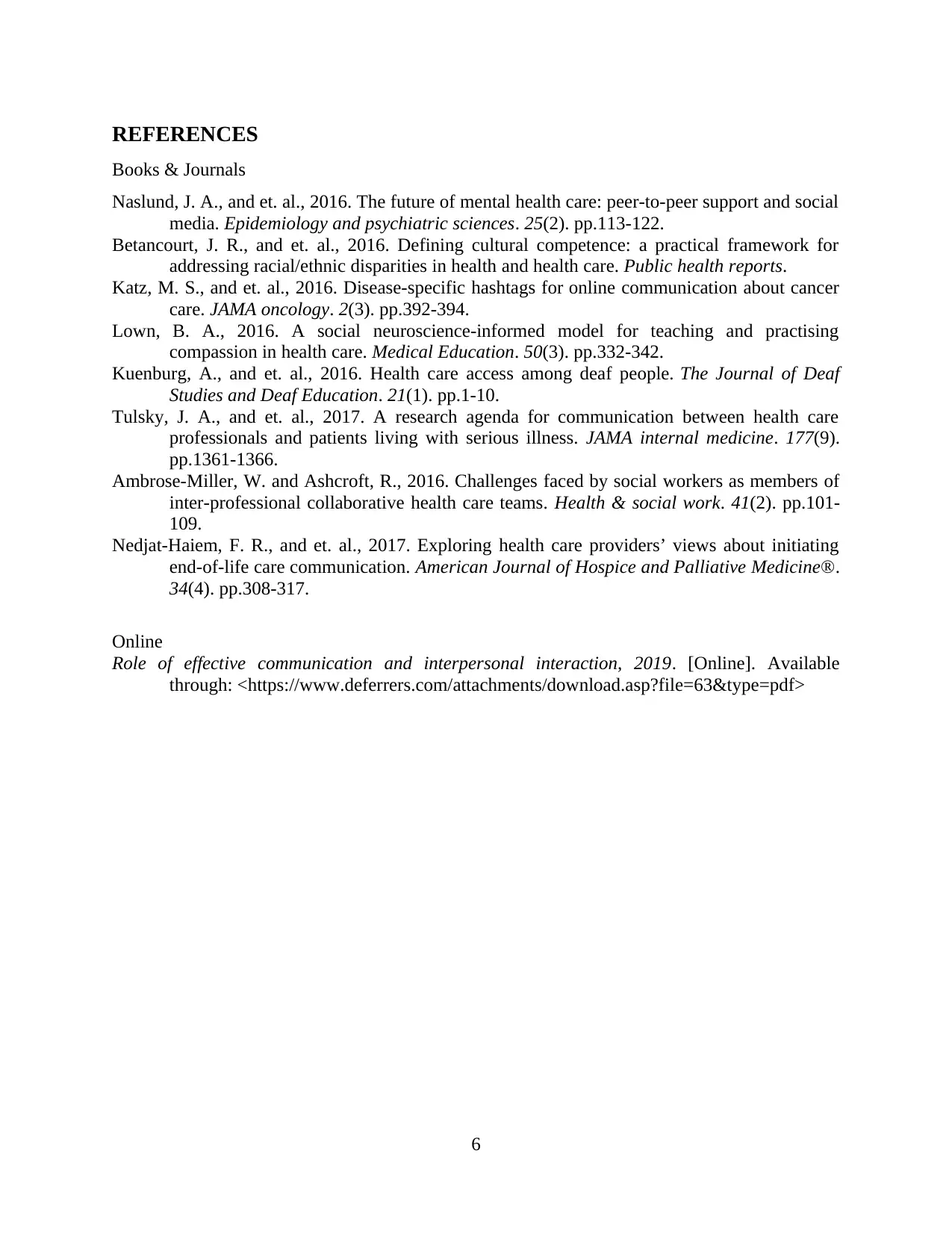
REFERENCES
Books & Journals
Naslund, J. A., and et. al., 2016. The future of mental health care: peer-to-peer support and social
media. Epidemiology and psychiatric sciences. 25(2). pp.113-122.
Betancourt, J. R., and et. al., 2016. Defining cultural competence: a practical framework for
addressing racial/ethnic disparities in health and health care. Public health reports.
Katz, M. S., and et. al., 2016. Disease-specific hashtags for online communication about cancer
care. JAMA oncology. 2(3). pp.392-394.
Lown, B. A., 2016. A social neuroscience‐informed model for teaching and practising
compassion in health care. Medical Education. 50(3). pp.332-342.
Kuenburg, A., and et. al., 2016. Health care access among deaf people. The Journal of Deaf
Studies and Deaf Education. 21(1). pp.1-10.
Tulsky, J. A., and et. al., 2017. A research agenda for communication between health care
professionals and patients living with serious illness. JAMA internal medicine. 177(9).
pp.1361-1366.
Ambrose-Miller, W. and Ashcroft, R., 2016. Challenges faced by social workers as members of
inter-professional collaborative health care teams. Health & social work. 41(2). pp.101-
109.
Nedjat-Haiem, F. R., and et. al., 2017. Exploring health care providers’ views about initiating
end-of-life care communication. American Journal of Hospice and Palliative Medicine®.
34(4). pp.308-317.
Online
Role of effective communication and interpersonal interaction, 2019. [Online]. Available
through: <https://www.deferrers.com/attachments/download.asp?file=63&type=pdf>
6
Books & Journals
Naslund, J. A., and et. al., 2016. The future of mental health care: peer-to-peer support and social
media. Epidemiology and psychiatric sciences. 25(2). pp.113-122.
Betancourt, J. R., and et. al., 2016. Defining cultural competence: a practical framework for
addressing racial/ethnic disparities in health and health care. Public health reports.
Katz, M. S., and et. al., 2016. Disease-specific hashtags for online communication about cancer
care. JAMA oncology. 2(3). pp.392-394.
Lown, B. A., 2016. A social neuroscience‐informed model for teaching and practising
compassion in health care. Medical Education. 50(3). pp.332-342.
Kuenburg, A., and et. al., 2016. Health care access among deaf people. The Journal of Deaf
Studies and Deaf Education. 21(1). pp.1-10.
Tulsky, J. A., and et. al., 2017. A research agenda for communication between health care
professionals and patients living with serious illness. JAMA internal medicine. 177(9).
pp.1361-1366.
Ambrose-Miller, W. and Ashcroft, R., 2016. Challenges faced by social workers as members of
inter-professional collaborative health care teams. Health & social work. 41(2). pp.101-
109.
Nedjat-Haiem, F. R., and et. al., 2017. Exploring health care providers’ views about initiating
end-of-life care communication. American Journal of Hospice and Palliative Medicine®.
34(4). pp.308-317.
Online
Role of effective communication and interpersonal interaction, 2019. [Online]. Available
through: <https://www.deferrers.com/attachments/download.asp?file=63&type=pdf>
6
⊘ This is a preview!⊘
Do you want full access?
Subscribe today to unlock all pages.

Trusted by 1+ million students worldwide
1 out of 9
Related Documents
Your All-in-One AI-Powered Toolkit for Academic Success.
+13062052269
info@desklib.com
Available 24*7 on WhatsApp / Email
![[object Object]](/_next/static/media/star-bottom.7253800d.svg)
Unlock your academic potential
Copyright © 2020–2025 A2Z Services. All Rights Reserved. Developed and managed by ZUCOL.




